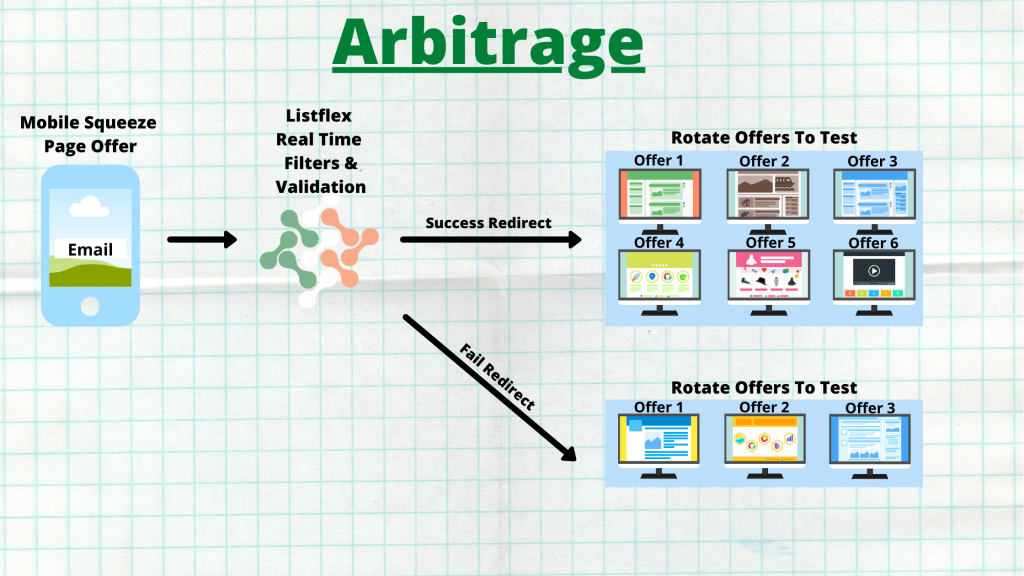Some of the biggest winners in our industry (and in the online marketing game in general) are simply people working for themselves with no product, no ecommerce store, no merchant accounts and often without employees.
If that sounds too good to be true, well…it’s not. But how can this be? How can an individual be labeled a “big winner” online without having a pile of overhead like expensive technology, staff and the like? Well, it’s a very simple concept called Arbitrage.
But before I get into the specifics of Arbitrage, I want to cover two basic questions that most people ask if they’re not already doing it.
1 – What exactly is Arbitrage?
2 – What’s the context in marketing?
The fine people at Google define arbitrage as:
ar·bi·trage
/ˈärbəˌträZH/
- the simultaneous buying and selling of securities, currency, or commodities in different markets or in derivative forms in order to take advantage of differing prices for the same asset.
“profitable arbitrage opportunities” -
buy and sell assets using arbitrage.“much of the short selling was being done by people who were arbitraging between the bond and the equity market”
So how does that definition convey to the online marketing industry? Here’s the easiest way to explain it. Imagine spending $1 in media buys (traffic), and having that dollar eventually spit out $2 to you from offers. In the same way realtors “flip” houses, you can arbitrage traffic or “flip” it for a profit using other people’s offers.
In this post I will explain a very basic, but proven arbitrage strategy that anyone can set up. Arbitrage seems to get overlooked quite a bit because of it’s simplicity, but it continues to be one of the easiest business models available to marketers.
So the story begins with me needing a quick site builder for some mobile traffic. This is before I had learned about Clickfunnels and other builders, so I bought some random mobile squeeze page builder off of JV Zoo. From there, we put it on a server and started testing a couple traffic sources for an idea that we had.
The idea was to take high paying offers in a specific niche and “weight” those offers off the back of our mobile squeeze pages. The niche we picked had lots of offers, lots of offer variations and were available on most affiliate networks. Knowing that there was no shortage of places to work with, we knew that we could easily line up 5-10 different versions of the offer (or similar niche offers) and start driving traffic to our mobile squeeze pages.
Our initial plan was that we could scale up list building for our internal email marketing aspirations. The goal was going to be simple, we just needed to break even on our adspend by finding offers to run off the back of our squeeze page, and build huge email lists. By choosing some of the more general niches, it wasn’t difficult to find a lot offers to test this theory.
That’s kind of where it all began. But we realized within about 2 weeks that we could quickly spin up new mobile squeeze pages for any vertical and “cycle” or “weight” lots of related niche offers off the back for a nice profit.
Here’s how it looked:
Traffic Source(s) ===> Squeeze Page (Listflex On Form) ===> Rotate Offers

(Listflex filters are running in the background in the mobile squeeze page form)
So we continued testing a variety of traffic sources and doing media buys to find really inexpensive, but quality clicks. We would collect the absolute minimum on the squeeze page, like email address only, and then redirect the lead.
But it didn’t take long before we could have cared less about the lists we were building. We found a couple traffic sources (all mobile) that delivered quality traffic and for super cheap (pennies per click). We would try to get the mobile squeeze pages to convert at 20-40% and then monitor the conversions from the offers on the back.
So, as an example, lets say you pay for 2500 clicks. What could that look like?
2500 clicks = $200-350 (depending on source)
750 email leads = Guessing email only squeeze getting 30% conversion
150 Clicks To = Offer 1 = $$$ Revenue
150 Clicks To = Offer 2 = $$$ Revenue
150 Clicks To = Offer 3 = $$$ Revenue
150 Clicks To = Offer 4 = $$$ Revenue
150 Clicks To = Offer 5 = $$$ Revenue
(* After about 100 clicks you quickly see what’s converting and what’s not so you can eliminate the loser offers and slowly add “weight” to the good offers, all while adding new versions to test with low volume.)
We quickly realized from the ad networks that our conversions and quality were phenomenal (sometimes too good and they got skeptical) because they continued asking us for more traffic. Why was the quality so good? Was it the traffic? We concluded it was a combination of things.
First, the traffic mattered. Second, the ONLY way a consumer could see a premium offer is if they entered a real working email or valid information into our form. So a ton of “looky Loo’s” and time wasters with fake info were weeded out to the fail redirect url. Listflex makes it easy to “fail redirect” anyone that puts bogus information into the form, so the garbage leads never make it to even see the good offers.
So only people that put real information into the forms got through to see the top offers on the back, and all of the rejected leads would go to a separate “fail redirect” url that worked exactly like the success. The fail redirect URL had “weighted” offers off the back of it as well, just not premium offers. Always adding and testing new “fail redirect” offers became all gravy to the profit margins as we fine tuned things. Keep in mind fail redirects could be a wrong country, invalid or any number of filters you can use when you set the list up inside of Listflex.
Here’s how we were monetizing the flow: $$$$
1 – Building our own lists & doing email marketing to the data
2 – Working with professional 3rd party email companies to help us monetize it further
3 – Testing lots of offers from networks (getting higher payouts because of quality)
4 – Scooping up extra money from “fail redirect” leads
If you are willing to do the work in finding some inexpensive mobile traffic, the arbitrage formula above is simple to put together. You need to be smart about the niches you choose, what networks you work with and the traffic sources you pick. But when it’s all flowing, it’s amazing to watch.
To date, this formula has provided me some of the biggest wins out of all the projects and companies we have ever put together. Offers, deals and networks come and go, but this system could be a super solid way to control your income and do incredible list building.
If you have any questions on this process or any of the moving parts, don’t hesitate to reach out to me our our team.
*Disclaimer: Arbitrage, like any business has significant risk. The strategy above might work for you, or it might fail. There’s no guarantee, implied or otherwise, on any earning potential of any kind. It’s impossible for me to know your experience, history or decision making ability. In the interest of safety, please assume the process above won’t make you any money. Any numbers or references to money in this post are strictly examples for reference and clarification. Consider all of the content in this post to be entertainment.




